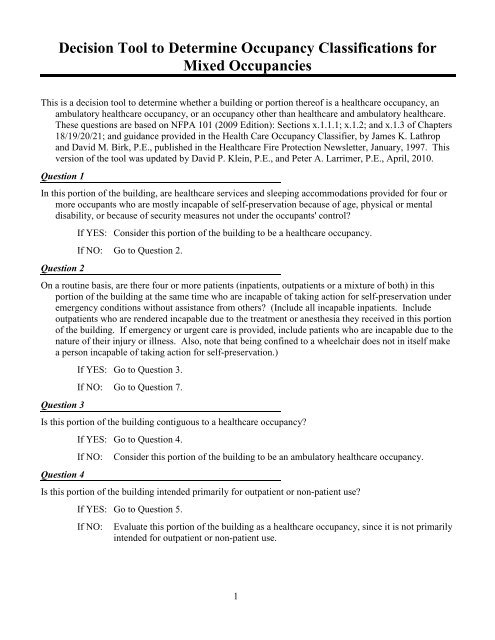Fire Protection Design Manual - Office of Construction and Facilities ...
Fire Protection Design Manual - Office of Construction and Facilities ...
Fire Protection Design Manual - Office of Construction and Facilities ...
Create successful ePaper yourself
Turn your PDF publications into a flip-book with our unique Google optimized e-Paper software.
Decision Tool to Determine Occupancy Classifications for<br />
Mixed Occupancies<br />
This is a decision tool to determine whether a building or portion there<strong>of</strong> is a healthcare occupancy, an<br />
ambulatory healthcare occupancy, or an occupancy other than healthcare <strong>and</strong> ambulatory healthcare.<br />
These questions are based on NFPA 101 (2009 Edition): Sections x.1.1.1; x.1.2; <strong>and</strong> x.1.3 <strong>of</strong> Chapters<br />
18/19/20/21; <strong>and</strong> guidance provided in the Health Care Occupancy Classifier, by James K. Lathrop<br />
<strong>and</strong> David M. Birk, P.E., published in the Healthcare <strong>Fire</strong> <strong>Protection</strong> Newsletter, January, 1997. This<br />
version <strong>of</strong> the tool was updated by David P. Klein, P.E., <strong>and</strong> Peter A. Larrimer, P.E., April, 2010.<br />
Question 1<br />
In this portion <strong>of</strong> the building, are healthcare services <strong>and</strong> sleeping accommodations provided for four or<br />
more occupants who are mostly incapable <strong>of</strong> self-preservation because <strong>of</strong> age, physical or mental<br />
disability, or because <strong>of</strong> security measures not under the occupants' control?<br />
Question 2<br />
If YES: Consider this portion <strong>of</strong> the building to be a healthcare occupancy.<br />
If NO: Go to Question 2.<br />
On a routine basis, are there four or more patients (inpatients, outpatients or a mixture <strong>of</strong> both) in this<br />
portion <strong>of</strong> the building at the same time who are incapable <strong>of</strong> taking action for self-preservation under<br />
emergency conditions without assistance from others? (Include all incapable inpatients. Include<br />
outpatients who are rendered incapable due to the treatment or anesthesia they received in this portion<br />
<strong>of</strong> the building. If emergency or urgent care is provided, include patients who are incapable due to the<br />
nature <strong>of</strong> their injury or illness. Also, note that being confined to a wheelchair does not in itself make<br />
a person incapable <strong>of</strong> taking action for self-preservation.)<br />
Question 3<br />
If YES: Go to Question 3.<br />
If NO: Go to Question 7.<br />
Is this portion <strong>of</strong> the building contiguous to a healthcare occupancy?<br />
Question 4<br />
If YES: Go to Question 4.<br />
If NO: Consider this portion <strong>of</strong> the building to be an ambulatory healthcare occupancy.<br />
Is this portion <strong>of</strong> the building intended primarily for outpatient or non-patient use?<br />
If YES: Go to Question 5.<br />
If NO: Evaluate this portion <strong>of</strong> the building as a healthcare occupancy, since it is not primarily<br />
intended for outpatient or non-patient use.<br />
1

















